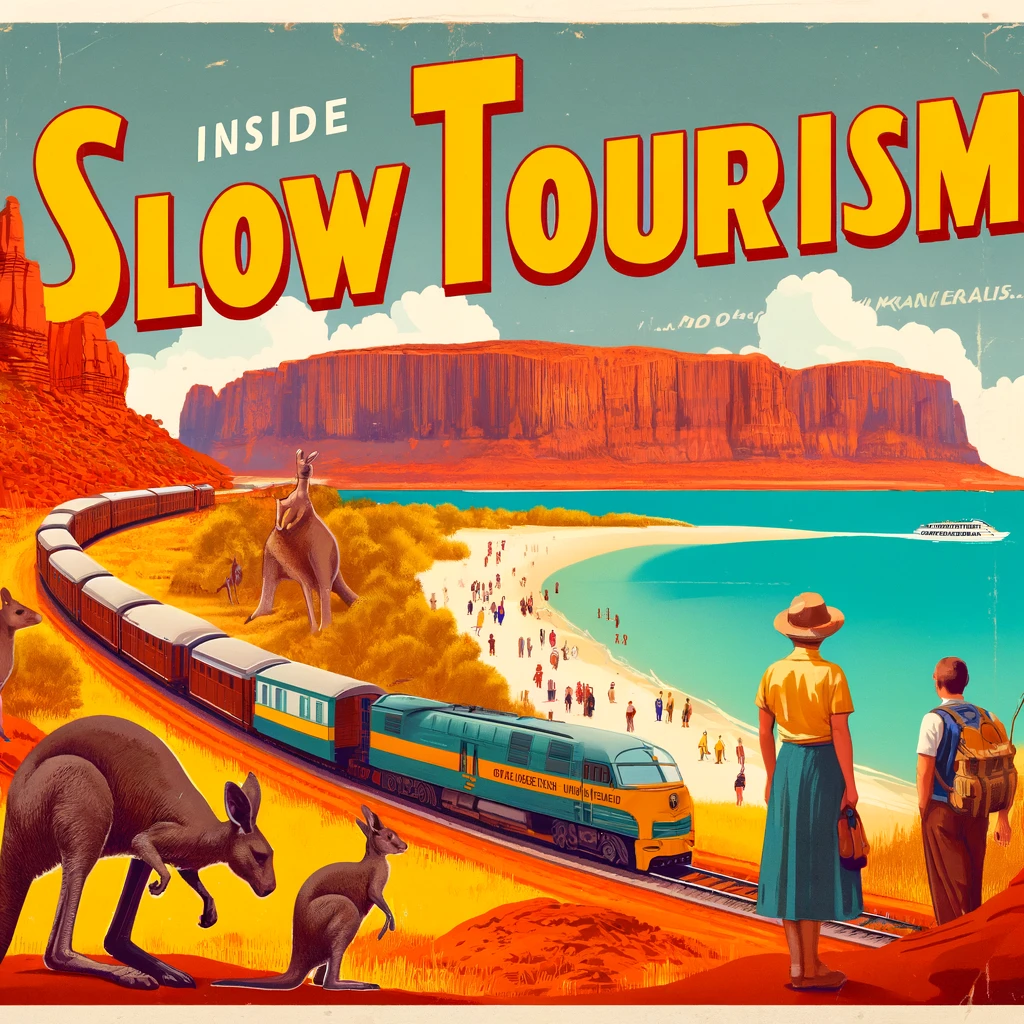
By Clara Winfeld
Imagine yourself aboard The Ghan, Australia's legendary transcontinental train, as it slices through the ochre expanse of the Red Centre. The rhythmic clatter of the tracks becomes a meditative soundtrack, lulling you into a state of reflection. Outside, the landscape unfolds at a leisurely pace—ancient rock formations, vast desert plains, and the occasional mob of kangaroos. In this unhurried journey, time seems to stretch, allowing you to fully absorb the vastness and beauty of the Australian outback.
The Rise of Slow Tourism
Travel today often feels like a race against time, with itineraries packed to the brim and little room for genuine connection. Sometimes it's literally high octane, as my colleague Rex Cassidy's Great Ocean Road investigation revealed. In response, a counter-movement is gaining momentum: slow tourism.
This philosophy champions depth over breadth, encouraging travelers to immerse themselves fully in a single destination rather than skimming the surface of many. In Australia, with its sprawling landscapes and rich cultural tapestries, slow tourism is not just a trend but a natural fit.A growing number of travelers are embracing slow tourism in Australia, driven by a desire to unplug from the constant buzz of technology and seek more soulful experiences.
Research from Tourism Australia shows a 4% increase in the average length of stay by international visitors compared to pre-pandemic levels, with extended trips contributing to a 3% rise in overall visitor expenditure.
Globally, studies, including a report by Booking.com, indicate a rising preference for slower, more immersive travel, with 75% of travelers expressing a desire to travel more sustainably and intentionally. In Australia, destinations that offer opportunities for cultural connection, environmental stewardship, and unhurried exploration are seeing increased interest from both domestic and international visitors.
Iconic Slow Tourism Experiences in Australia
For those who yearn to experience Australia’s heart and soul beyond the well-trodden paths, a quartet of extraordinary journeys awaits, each offering a tapestry of landscapes, stories, and connections.
The Ghan Expedition is a railway odyssey like no other. Stretching 2,979 kilometers from Darwin to Adelaide, it’s a three-day pilgrimage through Australia’s most striking contrasts. Beginning in the lush tropics, the train meanders into the ochre-hued Red Centre before arriving in the gentle temperate south. Along the way, passengers are invited to step off and step into the land itself, with guided excursions such as a visit to the ancient Nitmiluk Gorge. Here, towering sandstone cliffs and the serpentine river tell stories as old as time, offering travelers an intimate brush with the continent’s past.
Far to the southeast, the Wukalina Walk beckons with its blend of natural beauty and cultural immersion. This four-day trek through Tasmania’s Mount William National Park and the luminous Bay of Fires is more than a hike; it’s a journey into the rich traditions of the palawa people. Led by Indigenous guides, participants engage with age-old practices, hear stories passed through generations, and walk paths imbued with profound meaning. It’s a rare opportunity to see the island’s landscapes not just as breathtaking vistas, but as sacred chapters in an enduring narrative.
On the other side of the continent, the Kimberley coast unfurls in all its wild majesty, best explored through an expedition cruise. These voyages, intimate by design, open the door to one of the world’s last great wildernesses. Travelers glide past ancient rock art etched into cliffs, join Indigenous communities in vibrant cultural ceremonies, and stand in awe before natural spectacles like the mesmerizing Montgomery Reef. Here, time slows, inviting contemplation amidst the raw grandeur of the land.
For those craving serenity and simplicity, Australia’s remote eco-retreats offer a different kind of escape. In Tasmania and Western Australia, sanctuaries like Pumphouse Point and Sal Salis Ningaloo Reef provide a haven from the tyranny of screens. Guests trade Wi-Fi for wildlife, letting the rustle of leaves or the splash of a whale shark remind them what it feels like to be fully present. These retreats are not just about retreating from the world, but rediscovering one’s place within it.
The Impact on Indigenous and Regional Communities
Slow tourism has created meaningful opportunities for cultural exchange and economic empowerment in both Indigenous and regional communities. Experiences like the wukalina Walk and tours led by traditional custodians allow visitors to engage deeply with cultural knowledge while ensuring revenue flows directly into local communities. According to Tourism Research Australia, Indigenous tourism experiences contributed over $5 billion to the national economy, highlighting their significant economic and cultural value. Likewise, regional towns and remote areas have seen renewed vitality as slow tourism encourages longer stays and more thoughtful spending. These benefits support local businesses, create jobs, and help preserve cultural heritage. However, challenges remain, including the risks of cultural commodification, uneven economic distribution, and the need for careful visitor management to ensure long-term sustainability.
Reflection
Australia’s landscapes seem tailor-made for slow travel. Whether aboard a historic train, hiking through ancient trails, or simply sitting under a sky ablaze with stars, the continent rewards those who take their time. Slow tourism is not merely about seeing—it’s about understanding, respecting, and truly experiencing a place.In a world increasingly defined by urgency and distraction, perhaps the greatest luxury of all is time. And in Australia, time is best spent slowly.
What to know more: My sources are your sources, (except the confidential ones!)
- Journey Beyond Rail - The Ghan
- Tourism Research Australia International Tourism Results
- Booking.com Sustainable Travel Report
- wukalina Walk Official Site
- Pumphouse Point
- Sal Salis Ningaloo Reef
- Tourism Research Australia - Indigenous Tourism
- Tourism Research Australia Regional Tourism Data.
Safe Travels!
